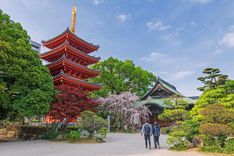Entering from the east, head through the huge San-mon gate to Daisen-in (大仙院) in the north of the compound. This sub-temple contains two gardens, the most famous of which is on the right as you enter the main hall. It replicates a Chinese landscape painting, and the garden uses carefully selected rocks, pebbles and a few scaled-down plants to conjure up jagged mountains.
It pays to visit Daisen-in early in the day before the crowds arrive. However, Daitoku-ji’s other sub-temples remain surprisingly quiet; probably the most interesting of these is Ryōgen-in (龍源院), lying just south of the San-mon gate. The temple was also founded in the early sixteenth century and is home to Japan’s smallest Zen rock garden. The minuscule Tōtekiko garden, on your right-hand side as you continue along the corridor from the entrance, consists of waves of sand round a rock, symbolizing a Zen saying that the harder a stone is thrown, the bigger the ripples.
Going to Kyoto? Prepare for your trip with our guide to the best places to stay in Kyoto.






